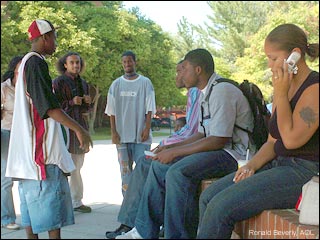A Faulty Explanation for the Gender Gap in Black Educational Attainment
Allow me to share with you this excerpt from a recent article in Diverse Issues in Higher Education (“Five Men, Five Different Views on Educating Black Males” by Cassie M. Chew):
Black males are discovering that they don’t need to ‘hit the books’ in order to make a living, and this is the reason behind recent statistics that report that as many as half of them drop out of high school and don’t pursue a college education.
There was a time when we were always taught that education was for us to get a good job, buy a house, raise a family — education doesn’t play the necessary role in those things any longer to young Black men,” according to poet, writer and filmmaker Malik Salaam.
Salaam was a member of a panel of five men who gave passionate, albeit divergent, views on how to make education a priority among today’s Black males during a forum convened by U.S. House Rep. Hank Johnson, D-Ga., at the Congressional Black Caucus Annual Legislative Conference last month.
During his opening statement, Johnson cited statistics from the Schott Foundation for Public Education’s December 2006 report, “A Positive Future for Black Males,” which found only 42 percent of Black males entering ninth grade will graduate. The report also found that Black students, who comprise 17 percent of public school students, make up 41 percent of special education placements, and 85 percent of these students, are boys.
“Instead of education being the foundation for economic stability, success in the music and entertainment businesses and the sale of illegal drugs has enabled some young Black men without high school diplomas to have nice homes and nice cars,” said Salaam, a poet featured on the HBO series “Def Poetry.”
“We have to market education as something that builds the self — that builds the inner person, that builds you as a human being — and get away from the material aspect of it because they can replace that easily with hip hop music and crack cocaine,” Salaam said.
I am disappointed by Salaam’s comments because they fail to make a distinction between perception and reality. While I agree that it is important for students to understand that the college experience is enriching and transforming in ways that cannot be immediately measured through the size of one’s paycheck, I take great issue with his suggestion that the reason teachers and advocates need to “market” higher education in this way (for its capacity to “build the self”) is because young Black men “can easily replace that [the economic benefits of higher education] with hip hop music and crack cocaine.”
While some young African American men may believe that selling drugs or becoming involved in the entertainment industry are viable alternatives paths to upward mobility, it is highly unlikely that “Black males are discovering that they don’t need to ‘hit the books’ in order to make a living.” Few who are involved in the drug trade ever make enough money to provide for even their own financial security (let alone their children’s or spouses’), and success as an entertainer is as statistically unlikely today as it has ever been.
Add to this the fact that those who find success “behind the scenes” of the music, television, and film industries (a much more attainable goal) are most often college-educated professionals (especially in the case of African Americans), and the folly of even the slightest suggestion that there is validity to some young (and, in many cases, underserved) Black men’s unrealistic investment in “making it” in the industry without education or formal training is magnified.
I am an advocate for those young folks who take an informed approached to work in the entertainment world – who pursue appropriate training and study, who educate themselves about their field, and who enter the entertainment workforce with a nuanced understanding of the steps required to truly gain job satisfaction and economic security within that industry.
My heart breaks, though, for the scores young men who eschew formal education partially due to their ill-informed belief that they will be discovered, so to speak, and propelled into the ranks of stardom>
Posted by Ajuan Mance
Posted in African American Students, Black Students, Current Events, gender gap, graduation rates, Higher Education, Hip Hop, Malik Salaam, Masculinity | 2 Comments »



